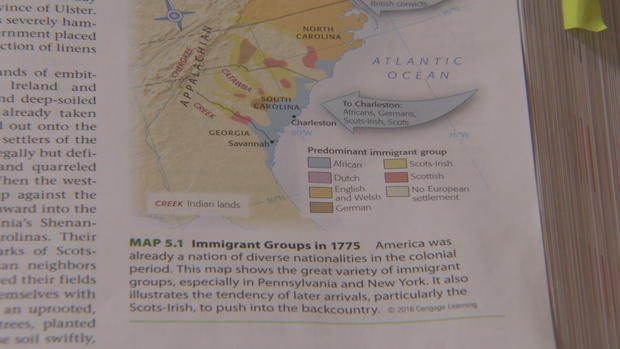Four years after a textbook publisher apologized for calling enslaved Africans “workers”, an investigation by CBS News has found problems with some four textbooks used in public school classrooms across the U.S.
One of the books is “The American Pageant,” which is widely used in Advanced Placement history classes in high schools across the country.
Reviewing the 16th edition of the book published in 2016 and how it affects the teaching of black history, CBS News found that a map in the book refers to enslaved Africans in 1775 as “immigrants.”
Other immigrant groups like the German, Dutch and Scottish are listed.

“To refer to them (Africans) again as immigrants insinuates that they chose to come,” said Dr. Ibram X. Kendi, the founding director of the Antiracist Research and Policy Center at American University.
“The African people who were almost totally … forced to come and certainly did not want to come to the United States in chains.”
CBS News also found the term, “mulatto” and “mulattoes” are used in the book. It cited one sentence that reads: “In the deeper South, many free blacks were mulattoes, usually the emancipated children of a white planter and his black mistress.”
“The term mulatto, in many ways, is a racial slur, is a racist slur against biracial people,” said Kendi. “The root of that word is mule, and so it was imagined in the decades leading up to the Civil War that biracial people were essentially like mules.
“In other words, it was imagined that black people and white people were separate species of being and so as a result, a biracial person, like a mule, would not be able to reproduce. And so that’s how and where the term mulatto came from. It was essentially a racist slur.”
For many people, the disturbing history of the slave trade brings to mind the horrifying experiences enslaved Africans had to go through while working on plantations in the Americas and other parts of the world.
Africans were, for centuries, captured and chained down, forced onto ships and taken into new lands against their will. Some even died before getting to their new homes due to the awful experiences on the ships that packed them like spoons, with no room even to turn.
For those who survived, it was the start of several hours of work on large plantations with little to eat and with never having to forget their status as property.
And 400 years after the first African slaves arrived in Virginia in 1619, narratives made in textbooks do still focus on the compassion of enslaved Africans and the profitability of slavery instead of the hardship and cruelty these enslaved Africans endued.
“Reviewing these texts closely, now I can see why so many students get to college and they’re like, ‘why didn’t we learn this in high school?’ because it isn’t in these texts.”
“When we instruct our children, we should be instructing them in truth,” Kendi said after reviewing some of the textbooks.
In October 2015, a parent hit hard at publisher McGraw-Hill for calling slaves from Africa “workers” in an educational textbook used in Texas.
In a Facebook video, the parent pointed out the issue under the World Geography textbook’s chapter titled “Patterns of Immigration.”
“The Atlantic Slave Trade between the 1500s and 1800s brought millions of workers from Africa to the southern United States to work on agricultural plantations,” a sentence from the book read.
McGraw-Hill Education replied with a statement on its Facebook page.
“This week, we became aware of a concern regarding a caption reference to slavery on a map in one of our world geography programs. This program addresses slavery in the world in several lessons and meets the learning objectives of the course. However, we conducted a close review of the content and agree that our language in that caption did not adequately convey that Africans were both forced into migration and to labor against their will as slaves,” the statement read.
“We believe we can do better. To communicate these facts more clearly, we will update this caption to describe the arrival of African slaves in the U.S. as a forced migration and emphasize that their work was done as slave labor,” it said.










